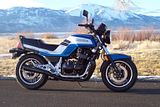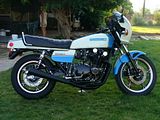Announcement
Collapse
No announcement yet.
High altitude question GS1150
Collapse
X
-
High altitude question GS1150
I live outside Reno, Nevada at an altitude of 5100 '. I took a ride over to Sacramento (elevation ~ sea level) and noticed a huge performance difference. It was like a put a turbo on the thing! But most all of my riding is at high altitude, 5000 to 8000 ft. The bike is stock. What can I do to the carbs to give my bike the best performance at these altitudes?Tags: None
-
Forum GuruCharter Member
GSResource Superstar
Past Site Supporter- Oct 2002
- 8860
- Angeles Forest, So.Calif./Red rocks of Southern Utah.
I agree with gsbill. It's completely normal for a motor to respond like yours. The factory does send us motors that are running on the lean side.
You would think (hope) that maybe this would counter the richening effect that your altitude gives but who knows if it's an "even" exchange? Even if it is "even", you're still drawing in less air than needed for best performance.
I would check the plugs. If their color is good I would leave it alone. If they're a little rich you can try adjusting the mixture screws IN about a 1/4 to 1/2 turn? This is just a guess. Actually, they are supposed to be set to achieve the highest rpm possible and then you re-set the idle to around 1,100 rpm with the idle screwknob. Do this on a warmed up motor and on the centerstand. If your screws still have the caps on be careful because the screws can be very tight and it's possible to strip the heads off. Even with the caps off they can be tight. Use a GOOD fitting tool if you adjust them. Put a little felt mark or ? on their present setting so you can put them back if you want to. I do not believe you would need to turn them in any more than 1/2 turn.
If you feel the bike is running a little sluggish now, you should be sure that it's tuned correctly FIRST. Carbs syched, clean air filter, good plugs, timing... I only mention the mixture screws because that's what they're for, fine tuning, depending on your conditions. And if you mark them, you can always put them back the way you found them.And on the seventh day,after resting from all that he had done,God went for a ride on his GS!
Upon seeing that it was good, he went out again on his ZX14! But just a little bit faster!
Comment
-
 mcconnell
mcconnell
The properly jetted engine at sea level will make about 15% more horsepower that the properly jetted engine at 5,000 feet. It's all in the oxygen.
Comment
-
 Anonymous
Anonymous
so for high altitude we should strap on grandmas oxy tank :twisted: :twisted:Originally posted by mcconnellThe properly jetted engine at sea level will make about 15% more horsepower that the properly jetted engine at 5,000 feet. It's all in the oxygen.
Comment
-
 Bolder Biker
Bolder Biker
That's my rule of thumb, too: about 3% loss of hp per 1,000 altitude. You definitely notice it at about 12,000 feet on Trailridge Road through the Rocky Mountain National Park! 8OOriginally posted by mcconnellThe properly jetted engine at sea level will make about 15% more horsepower that the properly jetted engine at 5,000 feet. It's all in the oxygen.
BB
Comment
-
 Anonymous
Anonymous -
 Bolder Biker
Bolder Biker
I haven't been up Pikes Peak on the bike yet, Don.Originally posted by Don Watsonbb what about pikes peak??
 I went up in my car once and encountered a blizzard in summer, though. 8O
I went up in my car once and encountered a blizzard in summer, though. 8O
BB
Comment
-
Forum GuruCharter Member
GSResource Superstar
Past Site Supporter- Oct 2002
- 8860
- Angeles Forest, So.Calif./Red rocks of Southern Utah.
Some people use a drill bit. Just be careful so you don't damage the screw under the cap. If you have a variable speed drill, set it low. Sometimes the bit will go through and snag the cap, removing it. Other times you drill a small hole and finish with needle nose pliers.And on the seventh day,after resting from all that he had done,God went for a ride on his GS!
Upon seeing that it was good, he went out again on his ZX14! But just a little bit faster!
Comment
-
 cbxchris
cbxchris
Kieth at very light throttle openings my 1150 has a very slight surging. I run a K&N filter with 4 into 1(competition baffle) and dyno jet stage 1 kit. I set the screws to recommended settings per dyno jet. Bike runs great other than that. SMOOTH on the road. Do you think this might help mine somewhat? Its so close I hate to mess with it really.
Comment
-
Forum GuruCharter Member
GSResource Superstar
Past Site Supporter- Oct 2002
- 8860
- Angeles Forest, So.Calif./Red rocks of Southern Utah.
Surging is a classic lean condition. When carbs are just above idle is when they're the most sensitive to being synched and they also show leanness problems. The mixture screws should be adjusted for the highest rpm possible and then re-set to about 1,100 with the idle screwknob. This is then followed by a good carb synch. You can always mark your screws and write down your adjustments. If you don't like the results, just put them back. Jet kits do tell you that you may have "driveability" issues with re-jetting. I've always had the most trouble at the same throttle position you describe. Do you still have the stock airbox lid on? Are any seals good?Originally posted by cbxchrisKieth at very light throttle openings my 1150 has a very slight surging. I run a K&N filter with 4 into 1(competition baffle) and dyno jet stage 1 kit. I set the screws to recommended settings per dyno jet. Bike runs great other than that. SMOOTH on the road. Do you think this might help mine somewhat? Its so close I hate to mess with it really.
If the above doesn't help, you may try going up one step (2.5) on your pilot jets. Did your stage 1 jet kit require increasing the vacuum orifice to the diaphragm chambers by drilling them out? Very important for throttle response. I know it's required with stage 3 kits.And on the seventh day,after resting from all that he had done,God went for a ride on his GS!
Upon seeing that it was good, he went out again on his ZX14! But just a little bit faster!
Comment
-
 cbxchris
cbxchris
Yes I drilled the carbs. Seals are good. I did a very good sync on the carbs. I probably will try your advice on getting it to idle at its highest rpm then reset idle and resync this winter. Its not bad at all but you can tell its just not quite right. Most would never notice it but I`m anal. Never really messed with these vacum carbs much....in my younger days I went for flat slides and then didn`t worry about anything but WIDE OPEN. Getting old I guess 8O
Comment
-
Forum GuruCharter Member
GSResource Superstar
Past Site Supporter- Oct 2002
- 8860
- Angeles Forest, So.Calif./Red rocks of Southern Utah.
Well, if the mixture screw adjustment does'nt help, you can always try a step up in the pilot jets.And on the seventh day,after resting from all that he had done,God went for a ride on his GS!
Upon seeing that it was good, he went out again on his ZX14! But just a little bit faster!
Comment
.png)


Comment